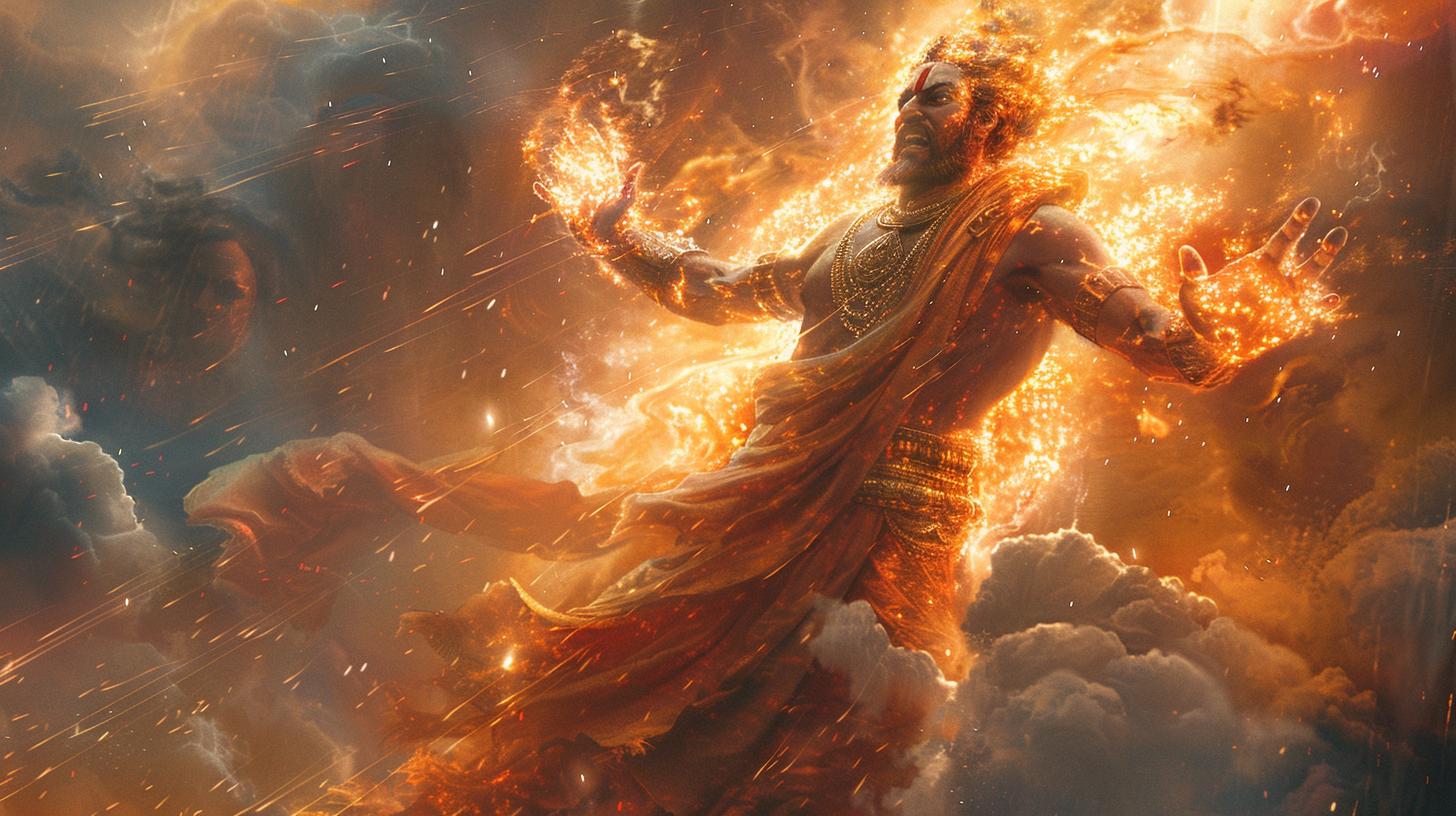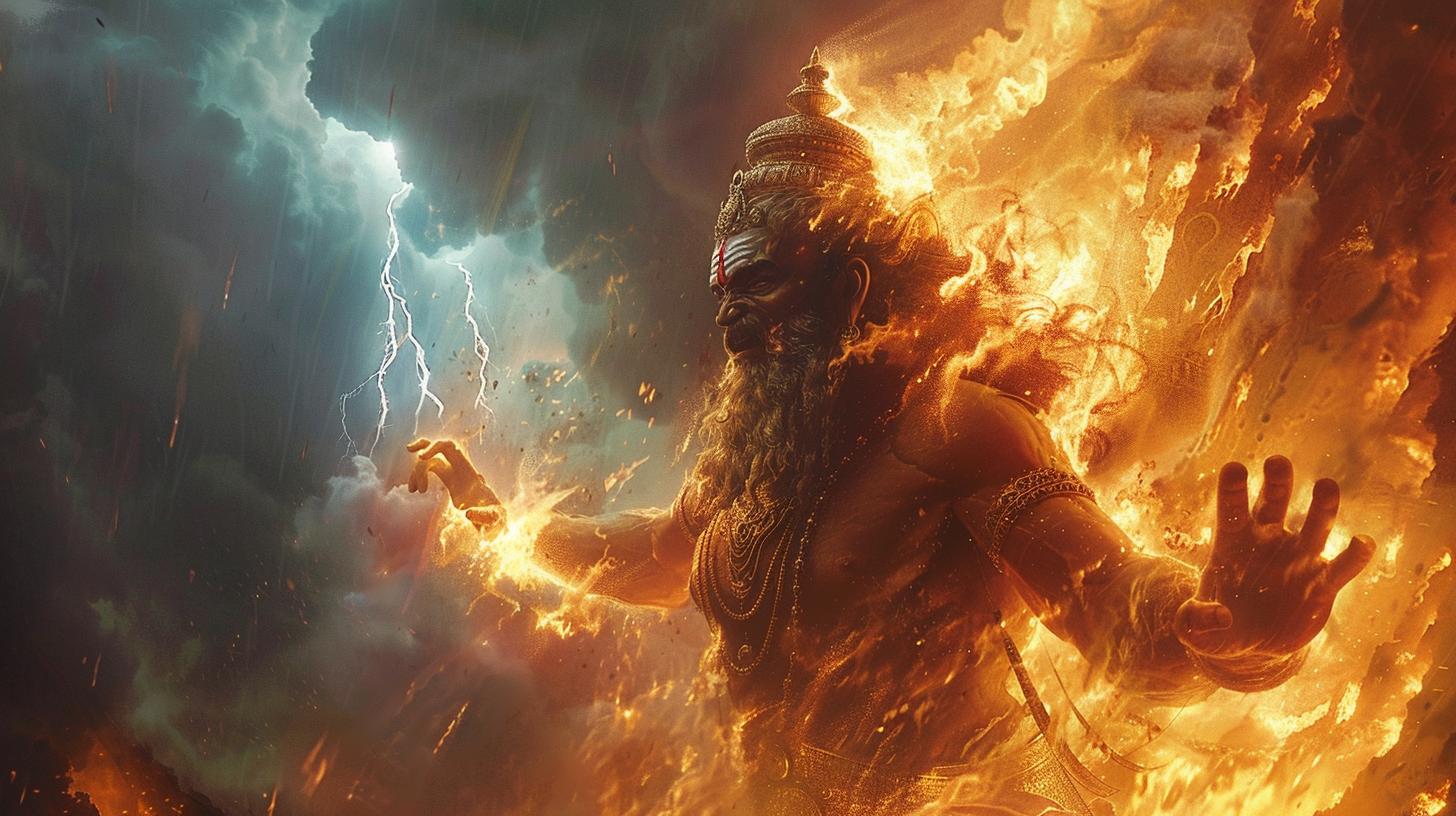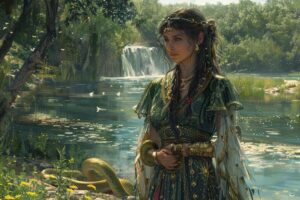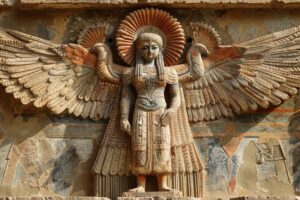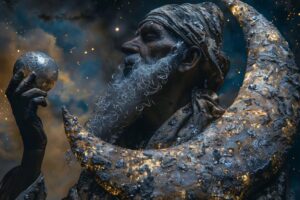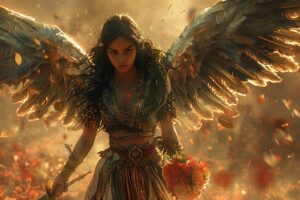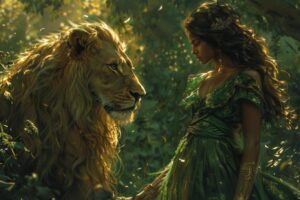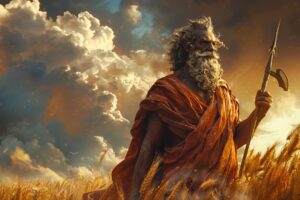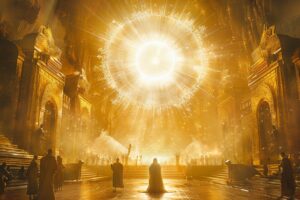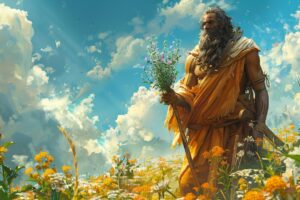Kumarbi Myth: The Father of Gods and His Rivalries in Hurrian Mythology
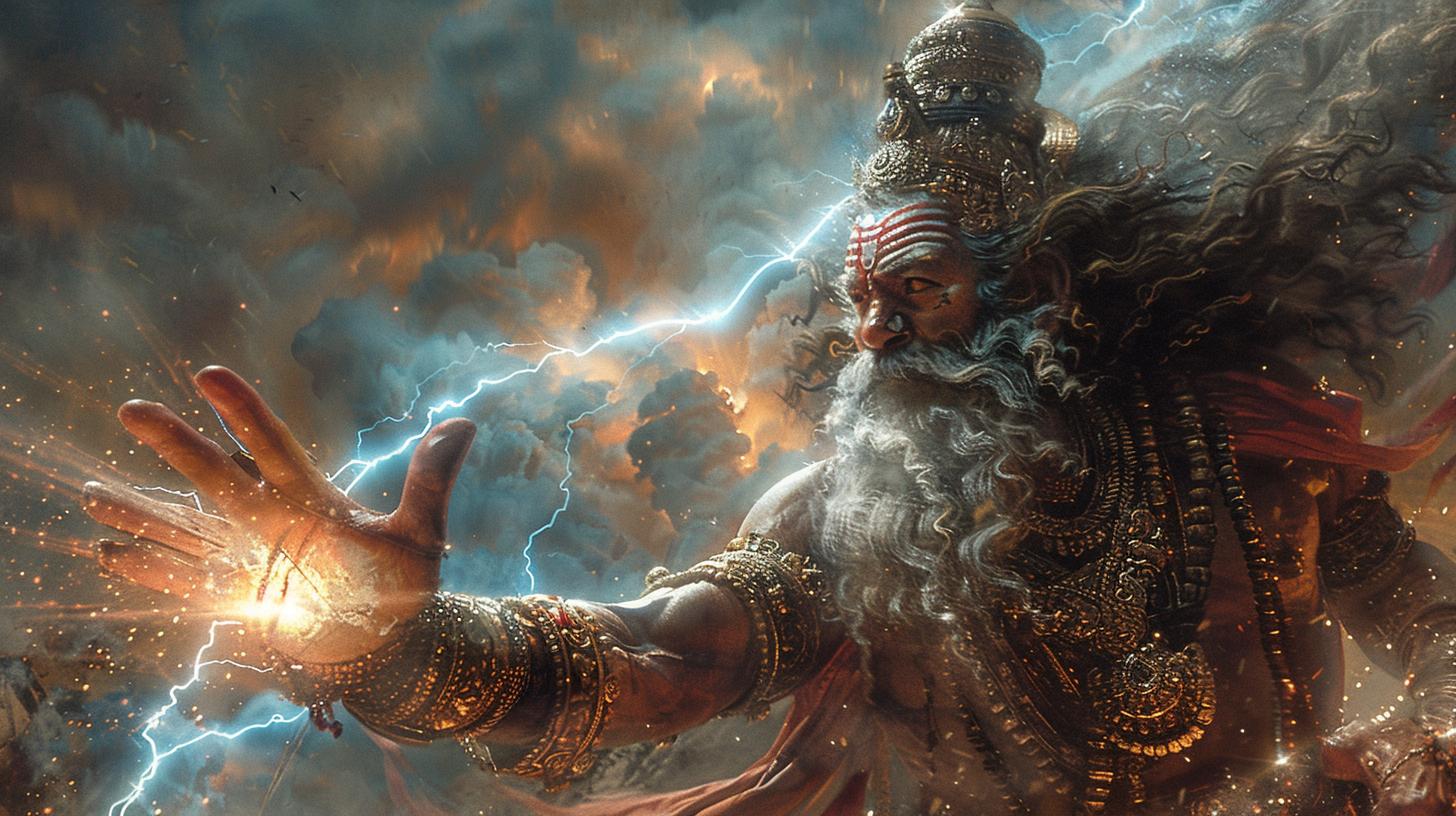
Kumarbi is a central figure in Hurrian mythology, often considered the ‘father of the gods.’ Known by various names, Kumarbi is depicted in several myths highlighting his complex role in the divine hierarchy.
His stories include significant conflicts, especially with his son Teshub. These narratives are part of the Kumarbi Cycle, a series of myths detailing battles for power and control among the gods.
Who is Kumarbi?
Kumarbi is a prominent deity in Hurrian mythology, known as the ‘father of the gods’ and central to many ancient myths.
Name and Representation
Etymology and Variations
The name Kumarbi, often vocalized as Kumurwe, Kumarwi, or Kumarma, translates to ‘he of Kumar.’ Although the place ‘Kumar’ is not documented in Hurrian sources, it is speculated to relate to the Hurrian root ‘kum,’ meaning ‘amass.’
In cuneiform, Kumarbi is written as dKu-mar-bi. In Nuzi, he is called Kumurwe. Ugaritic texts refer to him as kmrb or kmrw, vocalized as Kumarbi and Kumarwi. The variant Kumarma appears in Luwian hieroglyphic inscriptions, represented by (DEUS)BONUS, meaning ‘the good god.’
This representation is verified by inscriptions from Tell Ahmar.
Symbolism and Iconography
Kumarbi is frequently associated with agriculture and the prosperity of crops. His depictions often symbolize abundance and fertility due to these agricultural connections, though this is debated among scholars due to limited evidence.
Logographic Representations
In some texts, Kumarbi is logographically represented as dNISABA. This notation, used for Kumarbi and sometimes for Dagan in Ugarit, exploits the wordplay where the god’s name and the word for ‘grain,’ dgn, are homophones.
Kumarbi’s Lineage and Origins
Early Mentions in Hurrian Texts
Early Hurrian texts depict Kumarbi as an ancient deity with a significant role in the divine genealogy. These texts usually portray him engaged in conflicts with other gods, establishing his prominence in Hurrian cosmogonies.
Relationships with Other Deities
Kumarbi is closely associated with other significant deities in the Hurrian pantheon. He has notable relationships with gods like Teshub, his son and frequent adversary. Kumarbi’s parentage and his interactions with other gods, including his conflicts with Anu and alliance with gods like Dagan, further define his role in Hurrian mythology.
These relationships are vital in understanding the dynamics and tensions within the Hurrian pantheon, illustrating Kumarbi’s complex and multifaceted character.
The Role of Kumarbi in Hurrian Mythology
Kumarbi plays a vital role in Hurrian mythology, embodying themes of creation, conflict, and sovereignty.
The Father of Gods
Kumarbi’s Position in the Pantheon
Kumarbi is often depicted as the ‘father of the gods,’ a title reflecting his significant stature within the Hurrian pantheon. Despite this, his role is complex, involving both creation and conflict.
Although Kumarbi was once a principal deity, he frequently found himself replaced or challenged by his offspring, particularly Teshub.
Agricultural and Harvest Associations
In addition to his dominion over the gods, Kumarbi is also linked to themes of agriculture and harvest. This association is largely inferred from his depiction in various myths as a provider of prosperity and sustenance.
Some traditions view Kumarbi as a deity of the harvest, though evidence supporting this notion is somewhat limited.
Conflicts with Offspring
Biting of Anu’s Genitals
One of the most dramatic incidents involving Kumarbi is his conflict with Anu, the sky god. In a bid for supremacy, Kumarbi bites off Anu’s genitals, a violent act that leads to his absorption of Anu’s reproductive power.
This act of aggression sets the stage for the birth of several other significant deities, including Teshub, and symbolizes the complex relationships between the gods.
Birth and Rivalry with Teshub
Following the altercation with Anu, Kumarbi gives birth to Teshub, who emerges as a key rival. The tension between Kumarbi and Teshub is a central theme in Hurrian mythology, exemplifying the struggles for control within the divine hierarchy.
Teshub’s birth from Kumarbi sparks a series of conflicts, with Kumarbi continually attempting to undermine Teshub’s authority.
The rivalry between Kumarbi and his son Teshub encapsulates the recurring motif of intergenerational conflict within mythological traditions, highlighting the cyclical nature of power and succession among the gods.
The Kumarbi Cycle
The Kumarbi Cycle features a series of myths focusing on the conflicts between Kumarbi and his offspring, particularly Teshub.
The Song of Kumarbi (Song of Emergence)
This myth narrates Kumarbi’s rise to power after his victory over Anu and the ensuing conflicts with Teshub.
Kumarbi’s Victory Over Anu
Kumarbi triumphantly defeats Anu by biting off his genitals. This act not only symbolizes his takeover but also sets the stage for future conflicts by resulting in the birth of new gods, including Teshub.
Continuous Challenges by Teshub
Following Kumarbi’s initial victory, Teshub emerges as a significant adversary. The persistent challenges by Teshub against Kumarbi’s authority form the backbone of the subsequent myths in the cycle.
The Song of LAMMA
The introduction of the god LAMMA represents Kumarbi’s strategic attempts to bolster his power.
Introduction of LAMMA
Kumarbi enlists LAMMA with the intention of countering Teshub’s influence. This alliance reflects Kumarbi’s ongoing efforts to maintain his prominence through strategic partnerships.
LAMMA’s Defeat
Despite Kumarbi’s alliance, LAMMA is ultimately defeated. This outcome underscores the difficulty Kumarbi faces in retaining his position against the formidable challenges posed by Teshub.
The Song of Silver
Kumarbi’s alliance with the god of silver is another notable attempt to reinforce his dominance.
Alliance with the God of Silver
In this narrative, Kumarbi aligns with the god of silver, seeking to fortify his claim against Teshub. The collaboration highlights Kumarbi’s resourcefulness in seeking allies.
Outcome of the Battle
However, like previous attempts, the alliance ultimately fails. This defeat further cements Teshub’s ascendancy and reinforces the ongoing power struggle within the pantheon.
The Song of Ḫedammu
Kumarbi resorts to creating monstrous beings to challenge Teshub, reflecting the intensifying nature of their conflict.
Creation of the Sea Monster
Ḫedammu, a monstrous sea creature, is brought into existence by Kumarbi. This creation symbolizes Kumarbi’s desperate measures to subvert Teshub’s growing influence.
Defeat by Teshub
Despite the formidable nature of Ḫedammu, Teshub eventually overcomes the sea monster. This victory further solidifies Teshub’s dominance in the pantheon.
The Song of Ullikummi
The creation of Ullikummi, a stone giant, represents one of the most vivid episodes in the Kumarbi Cycle.
Birth of the Stone Giant
Kumarbi crafts Ullikummi from stone, aiming to unleash an unstoppable force against Teshub. This creation grows from the sea, posing an escalated threat to Teshub’s rule.
Ullikummi’s Ultimate Neutralization
Despite the significant threat posed by Ullikummi, he is eventually neutralized. Teshub’s victory against Ullikummi marks a pivotal moment in the Kumarbi Cycle, showcasing the recurring theme of succession and conflict among the gods.
Additional Myths Featuring Kumarbi
In addition to the Kumarbi Cycle, other significant myths featuring Kumarbi enrich Hurrian mythology by exploring his different roles and attributes.
Adaptation of Atrahasis
Kumarbi’s Role in the Hurrian Version
In the Hurrian adaptation of the Babylonian epic Atrahasis, Kumarbi assumes a central role that deviates distinctly from its Mesopotamian counterpart. The myth re-imagines Kumarbi as the principal deity responsible for key decisions affecting humankind.
This includes overseeing the creation and survival of humanity, portraying him in a more authoritative and influential role within the Hurrian context.
Comparison with Babylonian Myth
Compared to the Babylonian narrative where Enlil holds a similar position, Kumarbi’s portrayal in the Hurrian version highlights specific regional interpretations and theological nuances. In the Babylonian story, Enlil’s actions are marked by a series of destructive decisions, while Kumarbi’s role often reflects a more balanced, albeit complex, divine oversight.
Additional Songs
The Song of the Sea
This fragmentary text delves into a myth where Kumarbi’s actions influence the natural elements. The narrative may involve Kumarbi’s interaction with sea deities, reflecting his broader influence over nature and its forces within the Hurrian mythological framework.
The Song of the Oil
The Song of the Oil, another incomplete myth, potentially explores rituals and offerings associated with Kumarbi. It highlights the deity’s connection to agricultural prosperity and sacred rites, underlining his significance in maintaining the cycles of fertility and abundance.
Associations with Other Deities
Kumarbi’s role in Hurrian mythology extends through his associations with various other deities, reflecting his importance within the pantheon.
Kumarbi and Dagan
Shared Attributes and Roles
Kumarbi and Dagan share several attributes and roles, which highlight their significance in the Hurrian and Syrian pantheons. Both deities are connected through their associations with fertility and agriculture.
Kumarbi is sometimes linked with the harvest, while Dagan is a well-known fertility god in the region.
Dagan is considered a principal god in Syria, with influence over prosperity and the land, aligning with Kumarbi’s perceived role in the Hurrian context.
Relationship with Shalash
Shalash, a goddess intricately connected to both Kumarbi and Dagan, further bridges these two deities. She is often regarded as a consort or significant female counterpart, enhancing their standing within the divine hierarchy.
Shalash’s role as a mediator and interlinking figure serves to strengthen the bond between Kumarbi and Dagan, reflecting the syncretism in ancient religious practices.
Equivalent Gods in Different Pantheons
Kumarbi and Enlil
Kumarbi is frequently compared to Enlil, a major god in the Mesopotamian pantheon. From the 16th century BCE onwards, these two deities were seen as equivalent figures. Both hold positions as high deities within their respective cultures and share thematic elements such as control and fatherhood over gods.
Despite these parallels, Kumarbi and Enlil are not completely indistinguishable. Cultural contexts and specific mythological narratives provide distinct identities that prevent a total merging of their personas.
Comparisons with El and Ištaran
In Ugaritic texts, Kumarbi is aligned with the god El, another prominent deity. This comparison suggests a shared importance in the divine order, with both gods representing patriarchal figures within their mythologies.
El is known as the head of the Ugaritic pantheon, underscoring Kumarbi’s similarly elevated role. The continuity of Kumarbi’s worship into later periods hints at his long-lasting influence.
Additionally, Kumarbi may be associated with Ištaran in certain bilingual documents from Emar. Ištaran, a local deity with a distinct character, nonetheless shares attributes with Kumarbi, underlining the adaptability and integration of Kumarbi’s myth within various cultural frameworks.
Worship and Cult of Kumarbi
The worship and cult of Kumarbi extended across a broad geographic area, reflecting the god’s influence in various regions.
Spread of His Cult
Worship Sites from Anatolia to Zagros
Kumarbi was widely worshipped from Anatolia to the Zagros Mountains. Archaeological evidence points to numerous sites where he was venerated, showcasing his reach across diverse regions.
References in Urkesh and Mari
In Urkesh, Kumarbi is possibly referenced in royal inscriptions, highlighting his importance in early Hurrian centers.
Texts from Mari, dating to the early second millennium BCE, also mention rituals associated with Kumarbi, underscoring his significant religious role.
Rituals in Ugarit and Alalakh
Detailed documents from Ugarit and Alalakh describe specific rituals and offerings dedicated to Kumarbi. These practices illustrate how his worship was integrated into local religious traditions, reflecting his esteemed status among the gods.
Kumarbi in Hittite Religion
Kumarbi in Hattusa and Kizzuwatna
Kumarbi was incorporated into the Hittite pantheon, particularly in regions like Hattusa and Kizzuwatna. This integration involved a synthesis of Hurrian and Hittite religious practices, blending diverse cultural elements.
Representation in Yazılıkaya Sanctuary
The Yazılıkaya sanctuary includes depictions and inscriptions of Kumarbi, attesting to his veneration within the Hittite sacred landscape. These representations serve as a testament to his continued worship and the syncretic nature of ancient religions.
Continuation into the First Millennium BCE
Rituals in Taite and Assyrian Texts
In the first millennium BCE, Kumarbi’s cult persisted in areas like Taite, where his name appears in Assyrian ritual texts called Tākultu. These texts reveal ongoing religious practices dedicated to Kumarbi, indicating the durability of his worship over centuries.
Inscriptions in Carchemish and Tell Ahmar
Inscriptions from Carchemish and Tell Ahmar, written in Luwian hieroglyphs, document Kumarbi’s continued veneration. These records highlight his lasting presence in regional religious traditions, reflecting the enduring cultural exchange and influence.
Comparisons with Other Mythologies
The myths surrounding Kumarbi share similarities and differences with other ancient mythologies. These comparisons provide deeper insights into the common themes and unique aspects of these mythologies.
Mesopotamian Theogonies
Similarities with the Teogony of Dunnu
The Teogony of Dunnu offers several parallels with the myths of Kumarbi. In both mythologies, there are narratives involving succession crises among the gods. The creation and subsequent challenges for supremacy echo the patterns seen in Kumarbi’s struggles with Teshub.
For example, the story of Kumarbi biting off Anu’s genitals to seize power finds reflections in the generational conflicts of the Teogony of Dunnu. The eventual birth of rival deities from such violent acts highlights a recurrent motif of power struggles and divine progeny.
Differences from the Babylonian Stories
Despite these similarities, notable differences persist. Babylonian myths, such as the Enuma Elish, focus more on the cosmic creation and organization of the world, while the Kumarbi myths place a heavier emphasis on the interpersonal conflicts and battles for dominance among gods.
Furthermore, the roles of Teshub and Marduk differ substantially. While Teshub continuously combats his progenitor Kumarbi, Marduk’s rise in Babylonian myth is less fraught with recurring familial strife and more about his establishment of order from chaos.
Ugaritic Baal Cycle
Parallels in Divine Succession Stories
The Ugaritic Baal Cycle shares thematic elements with Kumarbi’s myths, particularly in the recurring themes of divine succession and battles for supremacy. Both mythologies revolve around younger gods challenging the established older orders to assert their own dominance.
In the Baal Cycle, Baal’s fight against Yam and Mot bears a resemblance to Teshub’s continuous battles with Kumarbi’s monstrous creations. These themes underscore a common cosmological narrative of order emerging from conflict.
Influence on the Baal Myths
Kumarbi’s legends may have influenced the Baal Cycle. Elements such as the birth of monstrous beings to challenge the reigning deities and the subsequent defeats resonate strongly with Kumarbi’s creation of Ullikummi and other creatures.
This suggests a shared cultural repository of myths wherein divine conflicts and transformations play central roles, pointing to a broader Syncretic tradition in ancient Near Eastern mythology.
Greek Mythology Influences
Comparisons with Hesiod’s Theogony
The myths surrounding Kumarbi show significant similarities with Hesiod’s Theogony. The motif of gods overthrowing their predecessors mirrors the struggles between Kumarbi, Anu, and Teshub with those between Uranus, Kronos, and Zeus in Greek mythology.
The act of Kumarbi biting off Anu’s genitals can be seen as a precursor to Kronos castrating Uranus. Both acts lead to consequential births, reflecting a shared narrative structure of succession and violent transition of power.
Traces in Orphic Texts like the Derveni Papyrus
Orphic texts, particularly the Derveni Papyrus, contain traces of the mythological themes found in Kumarbi’s stories. These texts explore the genesis of gods and their complex relationships, much like Kumarbi’s myth involves intricate family dynamics and power contests.
The influence of Hurrian mythology on Greek thought is evident, suggesting cross-cultural exchanges that enriched these ancient narratives, creating a syncretic blend of mythological traditions.
- Kumarbi and Hesiod’s narratives both involve divine succession and generational conflict.
- The themes of creation through violence and the consequential emergence of new deities are central to both traditions.
.

